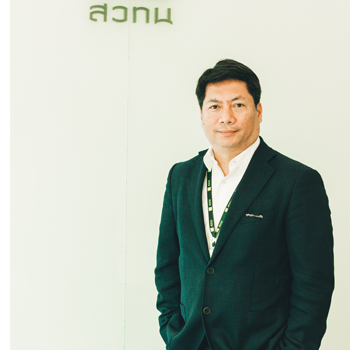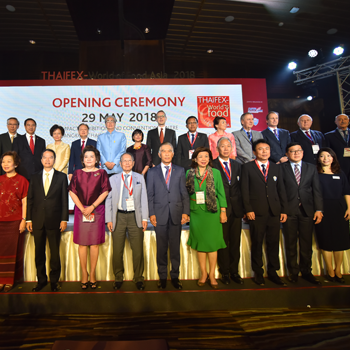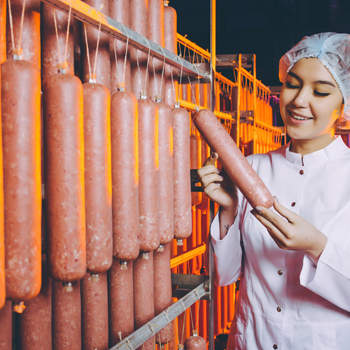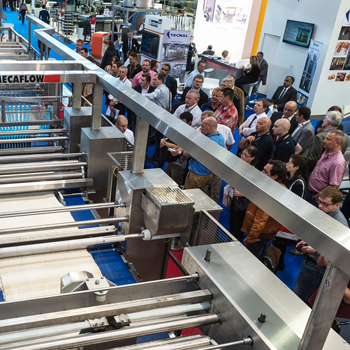Food Innopolis
เดินเกมนำ “วิทยาศาสตร์ เทคโนโลยี และนวัตกรรม” สู่การพัฒนาเศรษฐกิจ
By: Editorial Team
Food Focus Thailand Magazine
editor@foodfocusthailand.com
อุตสาหกรรมเกษตรและอาหารสร้างรายได้ให้กับประเทศของเราอย่างมหาศาล กว่าร้อยละ 80 ของทรัพยากรธรรมชาติในประเทศถูกนำมาประยุกต์ใช้ในอุตสาหกรรมอาหาร ปัจจุบันมีโรงงานแปรรูปอาหารในไทยกว่า 10,000 แห่ง มีการจ้างแรงงานกว่า 600,000 คน หากนับกันเฉพาะในภูมิภาคเอเชียแล้ว เมืองไทยของเราเป็นประเทศที่มีการส่งออกอาหารมากกว่าการนำเข้าเพียงประเทศเดียวเท่านั้น
สำนักงานคณะกรรมการนโยบายวิทยาศาสตร์ เทคโนโลยีและนวัตกรรมแห่งชาติ หรือ สวทน. สังกัดกระทรวงวิทยาศาสตร์และเทคโนโลยี เป็นอีกหนึ่งหน่วยงานที่มีบทบาทในการขับเคลื่อนเศรษฐกิจไทย โดยมองการณ์ไกลไปถึง 20 ปีข้างหน้า เดินเกมนำวิทยาศาสตร์ เทคโนโลยี และนวัตกรรม มาประยุกต์ใช้ในภาคอุตสาหกรรมเกษตรและอาหาร
“ภาคอุตสาหกรรมในประเทศไทยมากกว่าร้อยละ 50 เป็นอุตสาหกรรมเกษตรและอาหาร มีผู้ที่เกี่ยวข้องในภาพรวมถึง 39.8 ล้านคน นับเป็นครึ่งหนึ่งของจำนวนประชากรในประเทศ แต่เป็นที่น่าแปลกใจว่า GDP จากอุตสาหกรรมเกษตรและอาหารกลับอยู่ที่ร้อยละ 10 เท่านั้น” ผู้ช่วยศาสตราจารย์ ดร.อัครวิทย์ กาญจนโอภาษ รองเลขาธิการ สวทน. ในฐานะซีอีโอ เมืองนวัตกรรมอาหาร กล่าวเริ่มต้นกับ ฟู้ด โฟกัส ไทยแลนด์ พร้อมเสริมว่าอุตสาหกรรมเกษตรและอาหารในบ้านเรายังมีช่องว่างของความแตกต่างอยู่มาก รายที่มีขนาดใหญ่ก็จะมีศักยภาพสูง ส่วนรายขนาดกลางและเล็กซึ่งเป็นเส้นเลือดใหญ่ของประเทศ มีอยู่กว่าร้อยละ 90 ยังขาดศักยภาพและโอกาสในด้านงานวิจัยและพัฒนา สวทน. จึงได้จัดตั้งพื้นที่นวัตกรรมพิเศษสำหรับอุตสาหกรรมเกษตรและอาหาร หวังนำวิทยาศาสตร์ เทคโนโลยี และนวัตกรรม มาเชื่อมช่องว่างเหล่านี้
จนถึงปัจจุบัน ภาคเอกชนได้เข้ามาลงทุนจัดตั้งศูนย์วิจัยด้านอาหารโดยเฉพาะภายในเมืองนวัตกรรมอาหาร จำนวน 34 ราย และยังมีภาคเอกชนที่มีความสนใจอีกกว่า 60 ราย ทั้งนี้ มีภาคเอกชนจากต่างประเทศ คือ ญี่ปุ่น จำนวน 4 ราย ได้เข้ามาลงทุนแล้ว และมีเป้าหมายที่จะเชิญชวนผู้ประกอบการจากสหภาพยุโรป สหรัฐอเมริกา ออสเตรเลีย นิวซีแลนด์ และประเทศอื่นๆ ที่เป็นฐานการผลิตอาหารของโลกให้เข้ามาลงทุนเพิ่มเติม
เมืองนวัตกรรมอาหารจึงเป็นแม่เหล็กดึงดูดการลงทุนด้านการวิจัยและพัฒนาของผู้ประกอบการ ตลอดจนผู้ปฏิบัติงานที่มีความรู้เข้าสู่ประเทศไทย…เชื่อว่าหมากเกมนี้จะพลิกกระดานให้ไทยพร้อมด้วยอาวุธแห่งวิทยาศาสตร์ เทคโนโลยี และนวัตกรรม เดินหน้าพัฒนาเศรษฐกิจและอุตสาหกรรมเกษตรและอาหารให้มีความยั่งยืนต่อไป
The agricultural and food sector earns Thailand enormous revenues. More than 80 percent of the country’s natural resources are used in the food industry. There are currently more than 10,000 food processing factories countrywide, which contribute to the recruitment of over 600,000 workers. Thailand is the only country in Asia with food export exceeding import.
The National Science Technology and Innovation Policy Office (STI), Ministry of Science and Technology, is another government entity with a role in economic acceleration through the established vision that expands over the next 20 years by implementing Science, Technology and Innovation in the agricultural and food industry.
“Over fifty percent of Thai industrial sector is dedicated to food and agriculture, involving more than 39.8 million people overall, which is equal to half of the entire population. However, the agricultural and food industry surprisingly makes up only 10 percent of the GDP.”, said Assistant Professor Dr.Akkharawit Kanjana-Opas, Deputy Secretary of STI and CEO of Food Innopolis at the beginning of the interview with Food Focus Thailand. He added that the Thai agricultural and food sector is also challenged by a huge gap of difference. Bigger and well-established businesses wield greater potential while SMEs, which are the country’s main artery making up for more than 90 percent of the whole sector, are lacking in terms of potentiality and opportunities when it comes to R&D. STI, therefore, has created a special area of innovation for this particular industry in hope of bringing Science, Technology and Innovation in to narrow down the gap.
At present, 34 companies of the corporate sector have invested in the establishment of specialized food research centers, and over 60 more have so far expressed interest in following suit, with 4 Japanese firms already having initiated the investment. There are also plans to invite overseas entrepreneurs from Europe, USA, Australia, New Zealand, and other countries that are global major food manufacturers to invest in Thailand.
Food Innopolis will serve as a magnet attracting the investment in entrepreneurial R&D as well as knowledge workers to Thailand. These strategies are expected to put Thailand in an advantageous position and equip the country with weapons of Science, Technology and Innovation so that its economy, along with its agricultural and food industry, continues to prosper in a sustainable manner.









